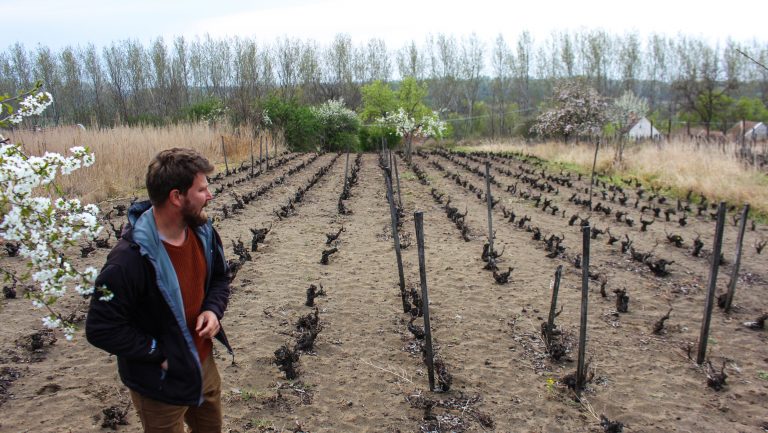Of the countries formerly located in Europe’s Eastern Bloc, Hungary has the best-known winemaking culture. After all, its wine history likely predates the Roman Empire, and the country’s most famous wine, Tokaji, first mentioned in the late 1400s, was subsequently lauded by centuries of kings and queens. In 2018, landlocked Hungary produced 3.4 million hectoliters of wine, sandwiching it between neighboring Romania (5.2 million hectoliters) and Austria (3 million hectoliters), according to the International Organisation of Vine and Wine.
However, the country’s wine production and reputation languished throughout much of the 20th century. “Today, the reasons it’s not as well known as, say, its neighboring Austria, are totally of a historical-political nature,” says Athena Bochanis, the founder of the Hungarian importer Palinkerie, which is based in New York City. During the world wars, vineyards were neglected or destroyed, and the country’s entire landscape was changed as the Austro-Hungarian state was dissolved in 1918. Collectivization followed in the 1950s, creating state-controlled mass production of wine that encouraged mechanization and the abandonment of quality hillside vineyards for high-yielding plantings on the plains. It wasn’t until the 1990s, after the fall of Communism, that the wine industry began to modernize.

“Hungarians today are still rebuilding their vineyards and wineries,” says Bochanis, “and in general do not have the capital to market themselves to the outside world the way winemakers in richer countries do.” After parcels of land were returned to their pre-Second World War owners and vineyards were available for purchase by both local winemakers and outside investors—among them Ribeira del Duero’s Vega-Sicilia and Bordeaux’s Cos d’Estournel—technology improved in wineries, hillside vineyards were revived, and better clones of local varieties were planted.

Don’t miss the latest drinks industry news and insights. Sign up for our award-winning newsletters and get insider intel, resources, and trends delivered to your inbox every week.
“Things are moving so fast [in Hungarian wine] that I can’t travel or read enough to keep up,” says Eric Danch, who recently cofounded the importing company Danch & Granger Selections in San Francisco; its portfolio includes 20 Hungarian wineries. Now the generation that brought Hungary’s wines back in the 1990s is giving way to a younger generation of enthusiastic winemakers who are further embracing native varieties, organic practices, and international recognition.
Hungary, however, still has obstacles to overcome. “Today the Hungarian wine industry is at an interesting moment in terms of growth,” says Bochanis. “The wines are getting better and better—there is no doubt about it. But there are several challenges facing the industry.” She notes that the total vineyard surface area in Hungary is shrinking—down to around 67,000 hectares in 2016 from 78,000 hectares in 2006—because of EU financial incentives to convert vineyards to corn and soy fields. Additionally, although more regional marketing organizations are emerging, there is little support at the state level for wineries, many of which are tiny and are struggling to scale up production.

Key Regions of Hungary
“Hungary is not cold,” says Bochanis. “It’s temperate, and grapes grow natively [throughout] the entire country.” With the hot summers and cold winters typical of a continental climate, Hungary is also influenced by the Danube River, running north-south through the center of the country, mountains in the north, and Europe’s largest lake, Lake Balaton, in the west. Many of the best vineyards are planted on south-facing hillsides, and there are volcanic soils throughout many of the regions.
Hungary has 22 wine regions, which have been classified into even more specific protected designations of origin and protected geographical indication regions, but broadly, they can be divided into three main areas: hilly north Hungary, where the country’s most famous wine regions are located; Transdanubia, which includes the western regions from which the U.S. is just starting to receive wines made from offbeat grapes and small producers; and the Great Plain, which is largely sandy and is home to more of the country’s paprika production than vines. The following are a few of the regions worth paying attention to right now.
Tokaj
Located in northeastern Hungary, along the Slovakian border, Tokaj has long been the country’s best-known region. Most of its vineyards are located on southeastern or south-facing slopes of volcanic soil, with the nearby Tisza and Bodrog Rivers providing the humidity necessary for the region’s famous botrytized sweet wines. Today, vintners in Tokaj are also making fantastic dry wines from the classic Furmint and Hárslevelű grapes.
Eger
Located southwest of Tokaj, Eger is one of the cooler, drier regions of Hungary, conditions that give its wines good acidity and aromatic intensity. After Tokaj, it is probably the most well region on the export market. Says Danch, “Most associate Eger with Bull’s Blood [a red blend], which is certainly still in play, but it also has the highest vineyard elevation in the country and a great mix of limestone and volcanic soils.” It’s becoming more common to find textured whites and light reds alongside the big, blended reds of the past.

Somló
Located on the slopes of an extinct volcano with basaltic soils, this tiny region is attracting new attention for its ability to produce mineral-laden white wines from the Juhfark grape.
Sopron
Just across the border from Austria and the famous Lake Neusiedl, this region focuses on bold reds made from Kékfrankos, more commonly known as Blaufränkisch.
Badacsony and Balatonfüred
These two small regions are located on the north shore of Lake Balaton, Europe’s largest lake, which helps moderate temperatures and increase ripeness. High-acid, aromatic, salty whites are common, but reds are making a comeback.
Szekszárd
Closer to the Croatian border in southern Hungary, Szekszárd is fairly hilly and warm, with the best sites located on eastern and southern slopes of loess soils. Blended or varietal reds from local or international grapes are common.
Villány
This region, located south of Szekszárd, where limestone is common, features terraced slopes where vintners have embraced Bordeaux varieties, particularly Cabernet Franc.
Key Grape Varieties in Hungary
The most-planted grape varieties in Hungary are Olaszrizling, or Welschriesling, which makes acid-driven white wines, and Kékfrankos, or Blaufränkisch, which makes spicy, deeply colored reds. Though common international varieties are planted in Hungary—notably Cabernet Franc, which has found a home in Villány—the country’s local grapes are far more exciting. These are four to know.
Furmint
Though it isn’t the most-planted variety, the most important Hungarian grape to know is Furmint, which is indigenous to Tokaj. “This variety is known for picking up the distinctive minerality of Tokaj’s soil,” says László Bálint, the Budapest-based founder of Furmint USA, an educational and marketing organization that promotes Hungarian wine in the U.S. market, “and beautifully expressing the terroir it has so perfectly adapted to over the centuries.” Though its susceptibility to botrytis and high acidity make it excellent for the production of sweet wines, it is increasingly being used to create fresh, fruity, mineral-tinged dry wines.

Hárslevelű
Typically known as a blending grape for Furmint, Hárslevelű is gaining attention as a varietal wine both within and outside Tokaj. It tends to be more aromatic than Furmint, with a round texture and spicy or mineral notes.
Juhfark
Almost exclusively planted in Somló, Juhfark is characterized by bracing acidity and, when planted in the right soils, strong minerality. “The name in Hungarian literally means ‘sheep’s tail,’” says Bálint, a nod to the shape of the grape bunches.
Kadarka
Once the most widely planted grape in Hungary, and historically the dominant grape in Bull’s Blood, Kadarka makes low-tannin, light-bodied wines that Bochanis calls Pinot-esque.

Dispatch
Sign up for our award-winning newsletter
Don’t miss the latest drinks industry news and insights—delivered to your inbox every week.
Courtney Schiessl Magrini is the editor-in-chief for SevenFifty Daily and the Beverage Media Group publications. Based in Brooklyn, she has held sommelier positions at some of New York’s top restaurants, including Marta, Dirty French, and Terroir, and her work has appeared in Wine Enthusiast, GuildSomm, Forbes.com, VinePair, EatingWell Magazine, and more. She holds the WSET Diploma in Wines. Follow her on Instagram at @takeittocourt.






